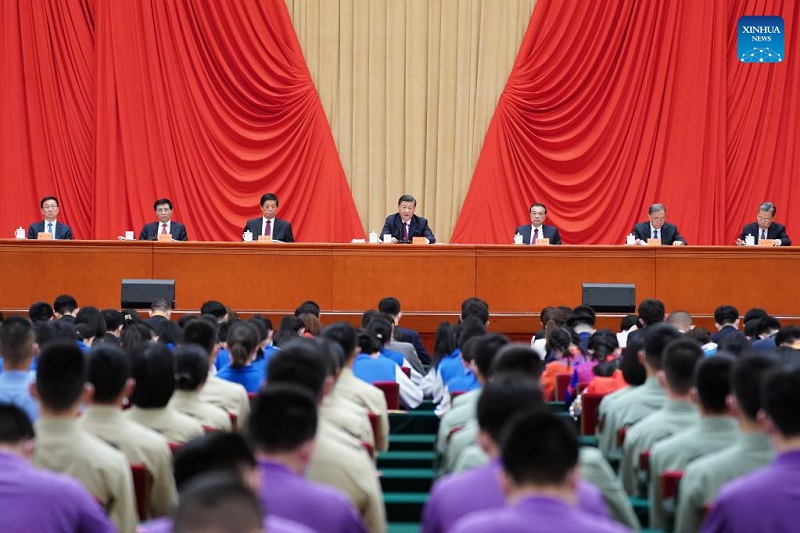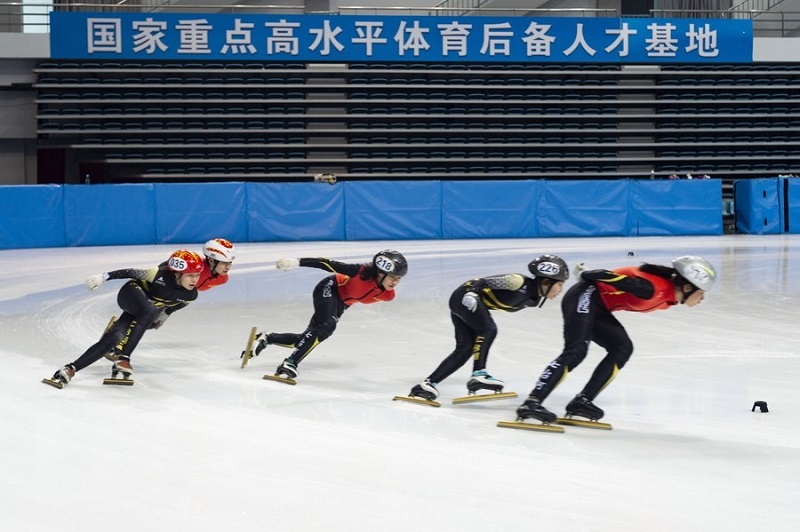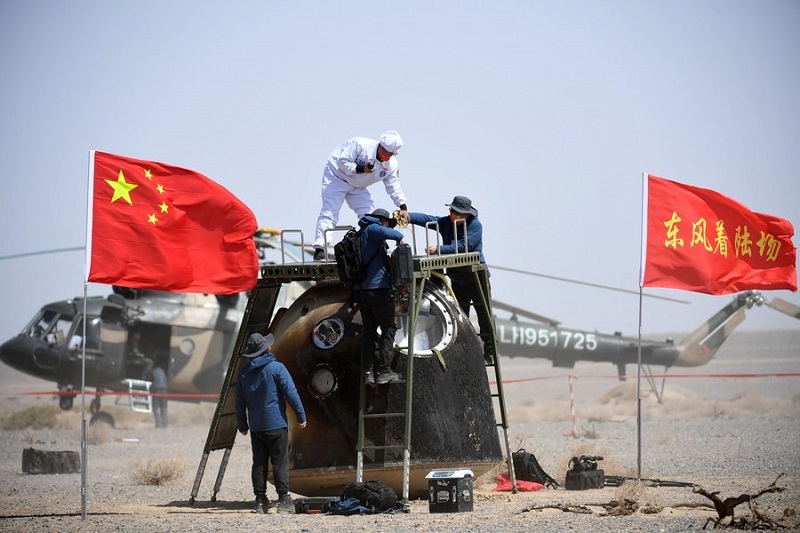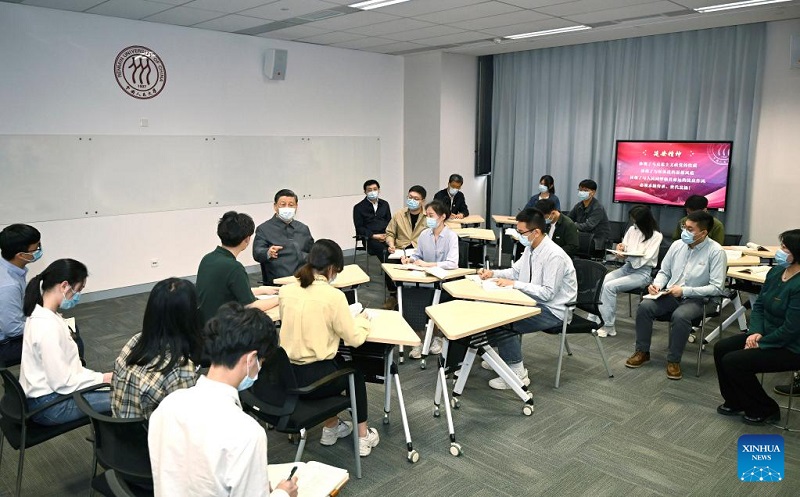Comparing the realization of the national rejuvenation to a relay race, Chinese President Xi Jinping called on young generations to strive for their best to help realize the Chinese Dream at a ceremony marking the centenary of the Communist Youth League of China (CYLC) in Beijing on May 10th. Xi, also general secretary of the Communist Party of China (CPC) Central Committee, remarked that a nation that places high hopes on its youth and maintains its youthful vigor can prosper.

Chinese President Xi Jinping, also general secretary of the Communist Party of China Central Committee and chairman of the Central Military Commission, delivers a speech at a ceremony marking the 100th anniversary of the founding of the Communist Youth League of China (CYLC) at the Great Hall of the People in Beijing on May 10, 2022. (Xinhua/Yan Yan)
Two weeks before that, President Xi called on the Chinese youth to be staunch believers, active disseminators, and exemplary followers of the core socialist values, while visiting Renmin University of China (RUC) on April 25, prior to National Youth Day, which falls on May 4.

Chinese President Xi Jinping waves to teachers and students during a visit to Renmin University of China in Beijing on April 25, 2022. (Xinhua/Xie Huanchi)
It has become a norm for President Xi to visit campuses, meet young people, and give them pep talks around Youth Day, as he said, “Every year around May 4, I reserve time for young people, listen to them, and chat with them.”
Impressive Progress
Xi attaches great importance to the education and development of young people. “The future belongs to the young people, and the hopes also rest with them,” Xi said at the grand gathering marking the centenary of the Communist Party of China (CPC) on July 1, 2021. Since the CPC’s 18th national congress in November 2012, China has tailored a raft of policies intended to create an enabling environment for young people’s growth. The country’s 13th and 14th five-year plans for national economic and social development both emphasized the role of young people and put their concerns into consideration. Young people’s needs were also given particular attention when the country put in place such major national strategies as the strategy for invigorating China through science and education, the innovation-driven development strategy, the rural revitalization strategy, and the Healthy China initiative.
In April 2017, the country’s first ever national plan about young people, the Middle- and Long-term Youth Development Plan (2016-2025), was released by the CPC Central Committee and the State Council. The plan set the target by 2025 to make the young people have greater theoretical and political literacy, significantly upgrade their all-round development, and enable them to grow into a generation with high aspirations, moral integrity, professional competence, broad minds, and an enterprising spirit who can shoulder the responsibility of realizing the Chinese Dream of national rejuvenation. Meanwhile, a range of projects have been rolled out to facilitate youth development under the plan, involving such areas as education, health, social security, marriage, and employment.
China’s Youth Day originated from the May Fourth Movement, which started with mass student protests on May 4, 1919 against the government’s response to the Treaty of Versailles that imposed unfair treaties on China and undermined the country’s sovereignty after the World War I. It soon sparked a national campaign to overthrow the old regime and promote new ideas, including science, democracy, and Marxism. Under the CPC's leadership, the Communist Youth League of China (CYLC) was established in 1922, opening a new chapter of the Chinese youth movement.
Noting that the May Fourth Movement was a great patriotic and revolutionary campaign pioneered by advanced young intellectuals, Xi Jinping said on April 30, 2019 at a gathering marking the centenary of the movement, “With its mighty force, the movement inspired the ambition and confidence of the Chinese people and nation to realize national rejuvenation.”
At the gathering, Xi also called upon the CPC to shoulder the political responsibility of nurturing a new generation of capable young people who have a good and all-round moral, intellectual, physical, and aesthetic grounding in addition to a hardworking spirit, and who are well-prepared to join the socialist cause.

Photo taken on Feb. 24, 2022 shows students of Qitaihe municipal youth amateur athletic school taking part in a short track speed skating training session at Qitaihe Sports Center in Qitaihe City, northeast China's Heilongjiang Province. (Xinhua/Xie Jianfei)
Data show that in 2021 the completion rate of compulsory education in China reached 95.4 percent, the gross enrollment rate in senior secondary education stood at 91.4 percent, and the gross enrollment rate in higher education rose to 57.8 percent with 44.3 million students on campus, placing the country in the top position in the world. China’s financial aid system has played an important role in helping students in need to complete their education with coverage from preschool to postgraduate education. By 2020, nearly 150 million students had received assistance with the total sum of subsidies amounting to RMB 240 billion.
Meanwhile, Chinese students have shown improved physical health. In 2018, 92 percent of students aged between 14 and 19 passed the physical fitness test, and the proportion of those rated good or excellent increased substantially, according to the white paper Youth of China in the New Era released by the State Council Information Office on April 21. At the same time, more than 37 million rural students receiving compulsory education have benefited from the student nutrition improvement program, which has helped improve their physical health. In addition, sports have become increasingly popular among young people as more and more sport and fitness venues have become available within their easy reach. The 2022 Beijing Olympic Winter Games further aroused Chinese young people’s passion in winter sports. The aforementioned white paper shows that youth aged 18 to 30 are the main force in winter sports in China, with the participation rate reaching 37.3 percent, the highest among all age groups.
Innovation Holds the Key to Future
President Xi has repeatedly stressed the importance of innovation for young people. After visiting an exhibition on science and technology achievements held at the University of Science and Technology of China in April 2016, Xi urged the young people to "dare to innovate" and called on the students to draw inspiration from China's leading scientists. On May 2, 2022, in a letter responding to a youth team working on space station construction at the China Aerospace Science and Technology Corporation (CASC), President Xi encouraged youth in the aerospace sector to contribute more to China's realization of greater self-reliance in aerospace science and technology.

The return capsule of China's Shenzhou-13 manned spaceship lands at the Dongfeng landing site in North China's Inner Mongolia autonomous region on April 16, 2022. [Photo/Xinhua]
On May 4, 2013, Xi visited the China Academy of Space Technology under the CASC, and held a discussion with outstanding youth representatives from all sectors. Nine years on, great advancements have been made in the country’s space industry, involving the BeiDou Navigation Satellite System satellites, Chang'e lunar probes, Tianwen-1 Mars probe, Xihe solar exploration satellite, as well as the Tiangong space station and its core module Tianhe. Seeing that a large number of young people in the sector have taken the lead and shouldered important responsibilities, Xi underlined, “Making China stronger in the aerospace sector requires continuous efforts across generations.”
The white paper Youth of China in the New Era shows that spurred by policy incentives, a large number of Chinese young have come to the fore in the country’s major sci-tech programs. The average age of the core members of the research groups on the Beidou Navigation Satellite System is 36; the corresponding figures are 35 for the quantum science satellite Mozi and 30 for the five-hundred-meter aperture spherical telescope (FAST) Tianyan. Every year more than 3 million science and technology and engineering students graduate from Chinese universities, continuously replenishing the country's legion of engineers.
An Issue of Paramount Importance
During his visit to the RUC campus on April 25, Xi joined the students for an ideological-political class. For many observers, it was no surprise at all that Xi would drop in on this class since the president once called the teaching of this subject an “issue close to heart.” When working in Fujian and Zhejiang provinces, Xi personally taught ideological-political lessons to college students. “Ideological and political courses are not only fundamental to building strong moral character but also irreplaceable,” he noted at a symposium attended by teachers of ideological-political courses in 2019.

Chinese President Xi Jinping sits with students, listening attentively and joining their discussions, at a smart classroom for ideological-political courses during a visit to Renmin University of China in Beijing, capital of China, April 25, 2022. (Xinhua/Yan Yan)
Ideological and political courses, including "Basic Principles of Marxism," " Brief History of Modern China," and "Social Values, Morality, and the Rule of Law," are listed as compulsory in China for undergraduate students, according to a Xinhua report.
During his recent RUC visit, Xi also pointed out that the essence of the course is reasoning, and attention should be given to the way of teaching how to reason in an insightful, thorough, and flexible way. He stressed that both teachers and students should be involved attentively in making heart-to-heart communications, enlightening and nourishing the mind, and motivating themselves. He called on teachers and students to continuously integrate the basic tenets of Marxism with China's actual conditions and with the fine traditional Chinese culture, and continue to adapt Marxism to the Chinese context and the current times, bearing in mind the overall strategy of the great rejuvenation of the Chinese nation and profound changes unseen in the world in a century.
A youth survey carried out in 2020 showed that the majority of China's youth wholeheartedly support socialism with Chinese characteristics and are full of confidence about the rejuvenation of the Chinese nation, according to the white paper Youth of China in the New Era. The white paper also indicated that younger generations are actively involved in politics and in China's practices of whole-process people's democracy, and an increasing number of them have applied to join the CPC. As of June 2021, the CPC had nearly 24 million members under the age of 35, representing 25 percent of its total membership. Since the Party's 18th National Congress in 2012, over 80 percent of the CPC members admitted each year aged under 35.
Meanwhile, the total number of the Communist Youth League of China (CYLC) members, who are all young people at the age of 14-28, have risen to more than 70 million. Emphasizing that the CYLC is truly the vanguard of China's youth movement, Xi summed up the key reasons to the success of the CYLC at CYLC’s centenary: the Party's leadership, firm beliefs and convictions, devotion to national rejuvenation, and its deep roots in the country's young people.